The Bundesmarine’s first destroyers: Although the Bundeswehr was integrated into NATO in 1955 and regained sovereignty over its territory, it would take some more years to organize the Bundesmarine in order to operate major units. Until then, the existing ships in service were merely minesweepers. However the drive towards larger units in order to lighten the burden of the Western navies within NATO was a logical one.
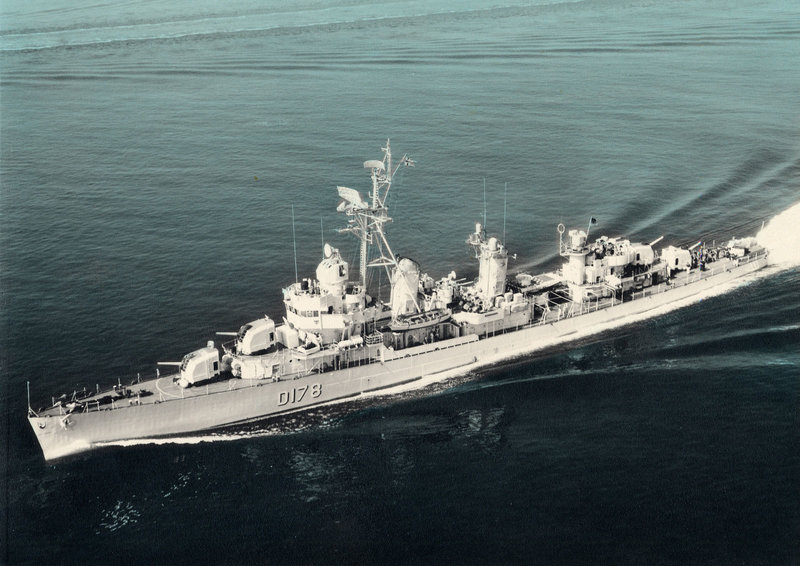
Zerstörer 4 underway – color. source
Since German yards would need time to gear up, a stopgap measure for NATO was to pick existing destroyer in the USN arsenal. This was the chosen solution for the German Z1 class, but after a full-blown modernization, and others will follow to keep the ships updated. The six Z1 class would serve actively until the 1980s, and afterwards through another operator, Greece.
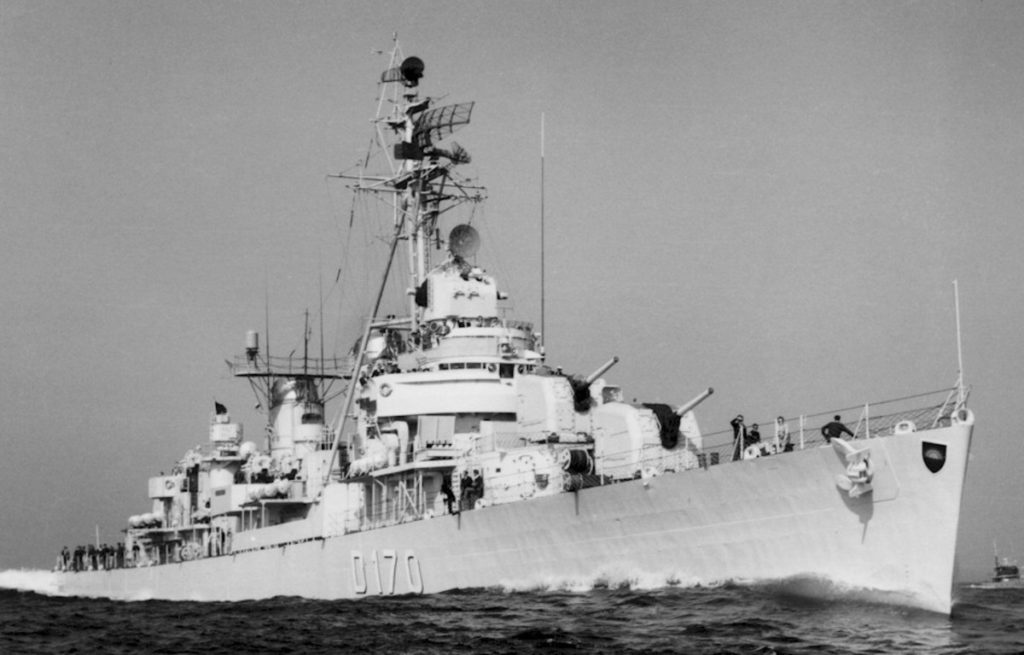
Ex-D-170 (Z.1) source
About the MDAP for Germany
Ships transfer were made under the MDAP program, from Germany as well as Italy and Spain. This program was a concrete traduction of the initial Mutual Defense Assistance Act signed by President Harry S. Truman in 1949. Registered as a part of the containment policy towards communism spreading around the world, the program provided military equipment to European countries until they were capable of rebuilding their own military industrial complexes.
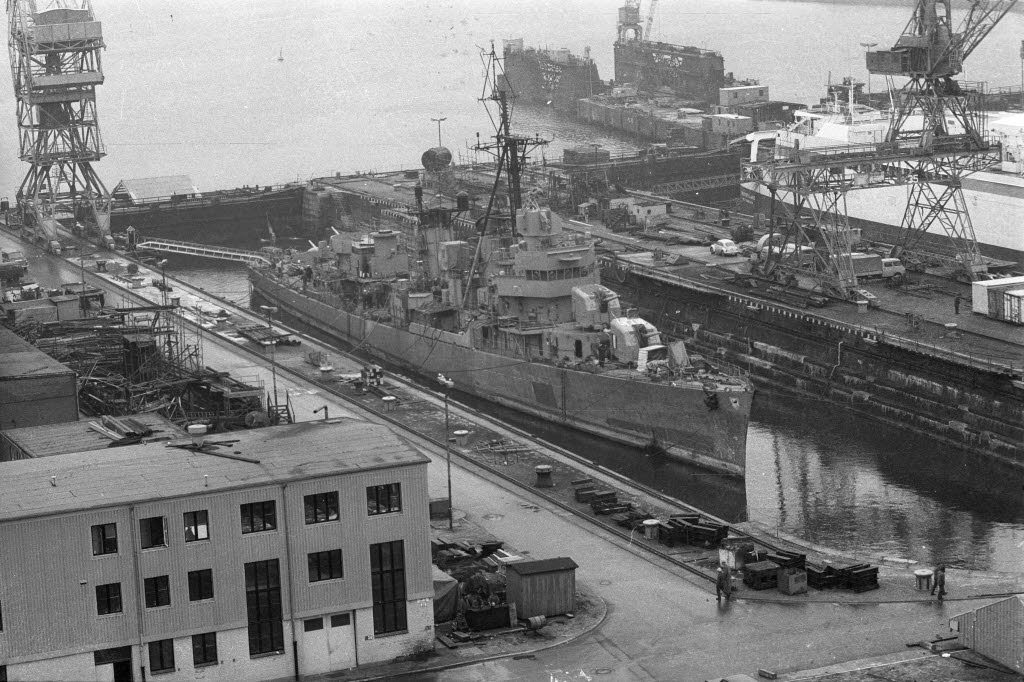
The Military Assistance Program, was instituted by law in 1950 and saw the annual military aid spending rose to 5,222 billion dollars. This concerned all sorts of military equipments, but mostly complex and costly ones, modern jets, tanks and ships. Small arms manufacturing was in general easier to set in place and remained national. For ships, the USN had a considerable arsenal of surplus warship inherited of the Atlantic ASW warfare and the pacific campaigns.
Cruisers and major capital ships were excluded (some surplus cruisers were sold to South America however), but light or escort aircraft carriers (as those deployed by France in Indochina), destroyers, frigates/escort DDs, minesweepers and landing ships however were frequently sent under this MDAP program to NATO countries.
About the Z1 class
The ships chosen in 1955 were destroyers of the Fletcher class, transferred in 1958, 1959 and 1960. Previously the USS Anthony (DD-515), Ringold (DD-500), Waldsworth (DD-515), Claxton (DD-571), Dyson (DD-572), and Charles Ausburne (DD-570). They were renamed Named “Zestörer 1” (German for ‘destroyer’) to 6 and D170-180, they had been leased for five years and comprehensively modernized: New electronics, and upon arrival, German controls and communication systems.
Their pennant number was changed to:
-D 170 FGS Zerstörer 1 (Z 1)
-D 171 FGS Zerstörer 2 (Z 2)
-D 172 FGS Zerstörer 3 (Z 3)
-D 178 FGS Zerstörer 4 (Z 4)
-D 179 FGS Zerstörer 5 (Z 5)
-D 180 FGS Zerstörer 6 (Z 6)
They entered service in 1959-1960.

Black and white schematic rendition of the Zerstörer class
About the Fletcher class
The Fletchers were the first mass-built class of destroyers of WW2 in the USN, and remained the largest ever, with 175 completed during the war, from 1941 to 1945. They were soon reinforced by radically new classes equipped with a more modern twin turret artillery, the Sumner and Gearing which made the other half of the total USN wartime destroyer force. Fletchers were mothballed in the 1940s, some modernized for ASW warfare or radar picket duties, and many either transferred under MDAP or sold to 14 countries (including Germany but also Spain, Italy), and also Taiwan, Turkey, Japan, South Korea, and most South American countries under the Monroe doctrine.
The Fletcher were still an interwar design, with five standard 5-in guns in single turrets, subtantial AA and two banks of torpedo tubes (2×5), but with simplifications in design like the flush-deck hull, and many details. There was no innovation here, the powerplant consisted in turbines of a trusted, proven design fed by cylindrical boilers. They were however all equipped with a radar from the onset and became grizzly veterans of the pacific war with impressive feats to their credit like during the battle of Leyte in 1944.
General characteristics of the Zerstörer class
The hull and powerplan stayed almost unchanged. As built, the Fletcher were 2750 tons ships fully loaded, 114,8 meters (376.5 feet) long by 12,0 meters (39.5 ft) wide and with 5,3 meters (17.5 ft) of draught. Their powerplan was unchanged, their speed was quite an advantage in ASW warfare against the new generation of Soviet fast attack submarines sch as the Whiskey.
It consisted of two propellers mounted on shafts driven by two General Electric geared steam turbines fed by four Babcock & Wilcox cylindrical, oil-firing boilers, rated in total for 60,000 shp or 45 Mega Watts. As a result, the ships were capable of 36 knots (67 km/h) and had a range of 3500 Nautical Miles at 15 knots (28 km/h) with 540 of oil, in the upgraded configuration (5500 nm originally). The crew consisted initially of 329 men, the new figures depended on the additional electronics management and ASW but was down to 244 men. These ships has been built in the 1941-42 series at Bath Iron Wks, Federal, Kearny, and Consolidated, Orange, in service originally from November 1942 to March 1943.
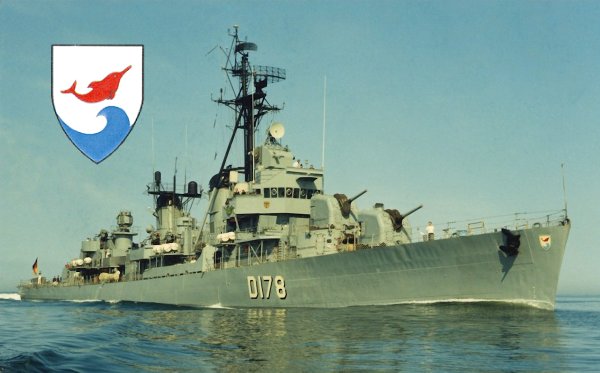
Z4 (D178) official Bundesmarine photo in 1970, on her way. Src
The original armament (before pre-transfer modernization) comprised 5 single 5”/38-caliber (127mm) guns, ten 2-pdr (40mm) Bofors AA guns, ten 20mm Oerlikon AA guns, ten 21” (533mm) torpedo tubes (two quintuple banks) with reloads, six depth charge projectors (K-guns) and two depth charge racks at the stern. This made these ships quite versatile.
Details of the modifications
The main changes were on the electronics side, with a tripod mast mad of the initial mainmast, behind the bridge. It was resting on two additional legs and supporting a massive aerial mounted on a large platform. A gun was removed and replaced by two Hedgehog type ASW projectors, torpedo tubes reduced and AA armament modernized. They also received after arrival additional German command systems.
Electronics:
This comprised a brand new array of aerials, a surface survey SPS-6, SPS-10 aerial (AA survey) Mk 25, two Mk 34 fire control systems, Mk 35 control radars, and for ASW detection, a passive SQS-29 sonar, and the WLR-1 ECM suite.
Armament of the Z1 class:
As revised, the armament was modified before transfer to four single 5”/38-caliber (127mm) guns (the central was deposed and replaced by additional equipments). They were the same model as the original Fletchers.
However the Z1 were fitted with six brand new 3″/L50 or 76mm AA guns in three twin mounts placed either side of the rear funnel, in the space between the two, and one on the superfiring position abaft the third turret. These were of the new Mk. 33 twin mount designed in 1950. The Allen M. Sumner and Gearing-class destroyers were the first upgraded with this caliber, and modernized Fletchers intended for transfers also. Thy shared a common power drive and could train at a rate of 30°/s, elevate 15°-85° at 24°/s automatically fed from an on-mount magazine replenished by two loaders, like the quad Bofors of WW2, but both the range and proximity fuze and fire-control radar made them accurate and harder hitting at 50 rpm, and overall better than the WW2 quad Bofors.
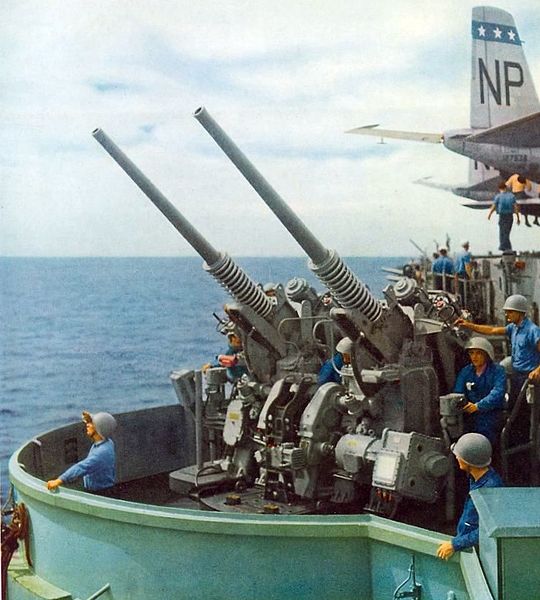
Twin 3″/L50 Mk.33 on the USS Wasp circa 1954.
The torpedo armament was modified also, with just the rear quintuple 21” (533mm) torpedo tubes bank remaining (with reloads probably still in place). However, two modernized, short-barrel extra 21” (533mm) torpedo tubes were installed on each side for ASW purpose, firing the new standard USN ASW torpedo.
Also were installed each side of the bridge two Hedgehog Anti-Submarine Projector Mk 15 ASWRL, with 178 reloads.
In complement there was still a single stern depth charge rack of the left side. The deck still comprised rails for mines although there is no evidence the ships ever carried some in exercizes.
Their armament was modified again in 1973-1975: Apparently the single side 21-in TTs were removed. In 1974, Zerstörer 4 gave up its 75 mm and kept only the rear twin 76/50 aft while a 76/62 OTO-Melara Compact was mounted for trials in place. In 1975 there was just the single 76/62 mm left for AA.
A video by Volker Buske of the model of Zerstorer 4 in 1970.
Active service
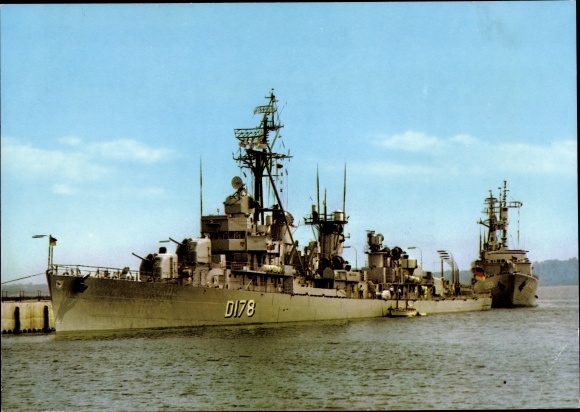
D178 at Schleswig-Holstein naval Yard –Src
All six destroyers served for a relatively short time in the Bundesmarine. They were a precious stopgap addition witing for the completion of the first missile cold war destroyers of the Lütjens class. They did their share of patrols as part of NATO’s baltic structure
Z6 (D180) was the first discarded, entering service on 12/4/1960 she was stricken on 10/1967, barely seven years in German service !. Z1 (D170) was stricken on 3/1972, whereas Z2 (D171) and the following were transferred to Greece on 9/1981 renamed Kimon, Z3 Nearkhos, Z4 was sold on 2/1981 for spare parts, as Z5.
For Z1, in detail, she was decommissioned on March 17, 1972, returned to the US on April 15, 1972, then stricken from USN lists the same day and resold to Germany for cannibalization & scrapping in June, stricken again in 1976 and sunk as a target on May 16, 1979 in the Mediterranean Sea.
Z2 was not returned to the USN and sold to Greece directly, entering service in the Hellenic Navy service in 1981 and under flag until 1987 as HS Kimon (D 42). She was placed in reserve but only stricken in 1993, and scrapped. Z3 was transferred one year earlier as HS Nearchos (D 65), but decommissioned later, in 1991, and scrapped afterwards. Z4 and Z5 used for spare parts remained unnamed in Greek service but scrapped at unknown date. Z6 had the shortest career and was not returned to the USN but decomm. on October 9, 1967 and scrapped afterwards.
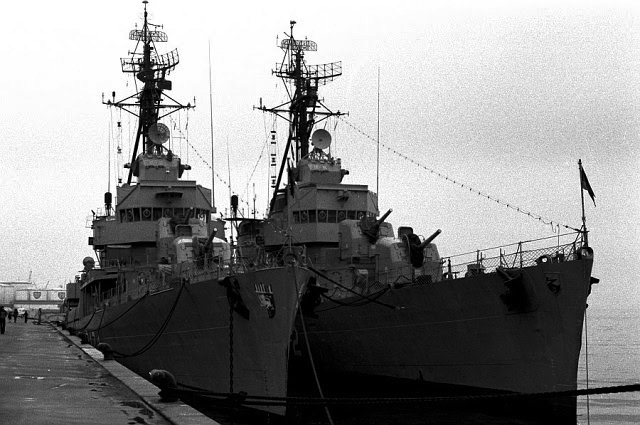
Two Z1 type destroyers at anchor (unknown) source
Characteristics of the Z1 class
| Displacement: | 2750 tons (full load) |
| Dimensions: | 114,8 x 12,0 x 5,3 m |
| Powerplant: | 2 shaft GE geared steam turbines, 4 B&W boilers (60000 shp/45 MW) |
| Top speed: | 36 knots (67 km/h) |
| Range: | 5500 NM (8850 km) at 15 knots (28 km/h) |
| Crew: | 244 |
| Armament: | (See Notes) – 4x 127mm, 6x 76mm, 5+2 533mm TTs, 2x Hedgehog, 1 DCT |
| Electronics: | SPS-6, SPS-10, Mk 25, 2x Mk 34, Mk 35 radars, SQS-29 sonar, WLR-1 ECM suite |
Sources/Read More
http://www.seaforces.org/marint/German-Navy/Destroyer/Type-119-Z-1-class.htm
http://www.navypedia.org/ships/germany/ger_dd_z1.htm
//web.archive.org/web/20040410163531/http://www.destroyersonline.com/usndd/classflet.html
//heinzalbers.org/z_1.htm
//www.schwiebert.lima-city.de/als-die-uss-claxton-zum-zerstrer-4-wurde/
//destroyerhistory.org/fletcherclass/
//www.patriotfiles.com/archive/ussclaxton/miscpics.htm
//onlinesales.randghomecare.com/index.php?main_page=product_info&products_id=20534 (cardboard kit)


 Latest Facebook Entry -
Latest Facebook Entry -  X(Tweeter) Naval Encyclopedia's deck archive
X(Tweeter) Naval Encyclopedia's deck archive Instagram (@navalencyc)
Instagram (@navalencyc)





 French Navy
French Navy Royal Navy
Royal Navy Russian Navy
Russian Navy Armada Espanola
Armada Espanola Austrian Navy
Austrian Navy K.u.K. Kriegsmarine
K.u.K. Kriegsmarine Dansk Marine
Dansk Marine Nautiko Hellenon
Nautiko Hellenon Koninklije Marine 1870
Koninklije Marine 1870 Marinha do Brasil
Marinha do Brasil Osmanlı Donanması
Osmanlı Donanması Marina Do Peru
Marina Do Peru Marinha do Portugal
Marinha do Portugal Regia Marina 1870
Regia Marina 1870 Nihhon Kaigun 1870
Nihhon Kaigun 1870 Preußische Marine 1870
Preußische Marine 1870 Russkiy Flot 1870
Russkiy Flot 1870 Svenska marinen
Svenska marinen Søværnet
Søværnet Union Navy
Union Navy Confederate Navy
Confederate Navy Armada de Argentina
Armada de Argentina Imperial Chinese Navy
Imperial Chinese Navy Marinha do Portugal
Marinha do Portugal Mexico
Mexico Kaiserliche Marine
Kaiserliche Marine 1898 US Navy
1898 US Navy Sovietskiy Flot
Sovietskiy Flot Royal Canadian Navy
Royal Canadian Navy Royal Australian Navy
Royal Australian Navy RNZN Fleet
RNZN Fleet Chinese Navy 1937
Chinese Navy 1937 Kriegsmarine
Kriegsmarine Chilean Navy
Chilean Navy Danish Navy
Danish Navy Finnish Navy
Finnish Navy Hellenic Navy
Hellenic Navy Polish Navy
Polish Navy Romanian Navy
Romanian Navy Turkish Navy
Turkish Navy Royal Yugoslav Navy
Royal Yugoslav Navy Royal Thai Navy
Royal Thai Navy Minor Navies
Minor Navies Albania
Albania Austria
Austria Belgium
Belgium Columbia
Columbia Costa Rica
Costa Rica Cuba
Cuba Czechoslovakia
Czechoslovakia Dominican Republic
Dominican Republic Haiti
Haiti Hungary
Hungary Honduras
Honduras Estonia
Estonia Iceland
Iceland Eire
Eire Equador
Equador Iran
Iran Iraq
Iraq Latvia
Latvia Liberia
Liberia Lithuania
Lithuania Mandchukuo
Mandchukuo Morocco
Morocco Nicaragua
Nicaragua Persia
Persia San Salvador
San Salvador Sarawak
Sarawak Uruguay
Uruguay Venezuela
Venezuela Zanzibar
Zanzibar Warsaw Pact Navies
Warsaw Pact Navies Bulgaria
Bulgaria Hungary
Hungary

 Bundesmarine
Bundesmarine Dutch Navy
Dutch Navy Hellenic Navy
Hellenic Navy Marina Militare
Marina Militare Yugoslav Navy
Yugoslav Navy Chinese Navy
Chinese Navy Indian Navy
Indian Navy Indonesian Navy
Indonesian Navy JMSDF
JMSDF North Korean Navy
North Korean Navy Pakistani Navy
Pakistani Navy Philippines Navy
Philippines Navy ROKN
ROKN Rep. of Singapore Navy
Rep. of Singapore Navy Taiwanese Navy
Taiwanese Navy IDF Navy
IDF Navy Saudi Navy
Saudi Navy Royal New Zealand Navy
Royal New Zealand Navy Egyptian Navy
Egyptian Navy South African Navy
South African Navy






























 Ukrainian Navy
Ukrainian Navy dbodesign
dbodesign